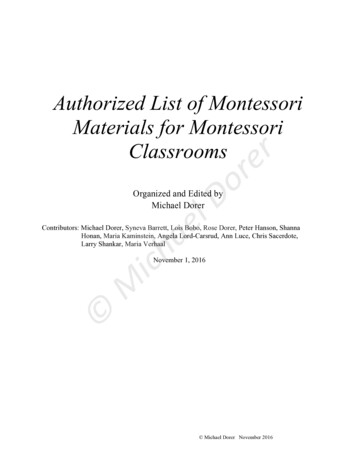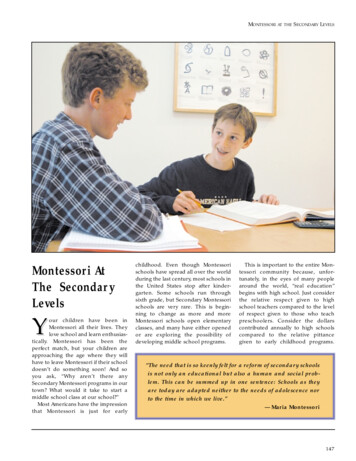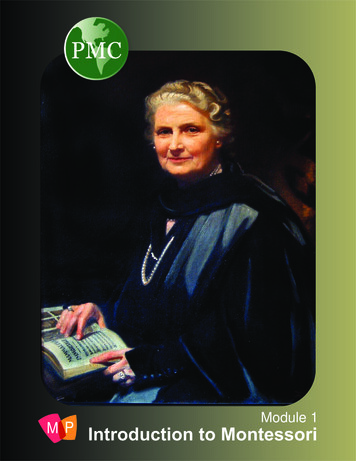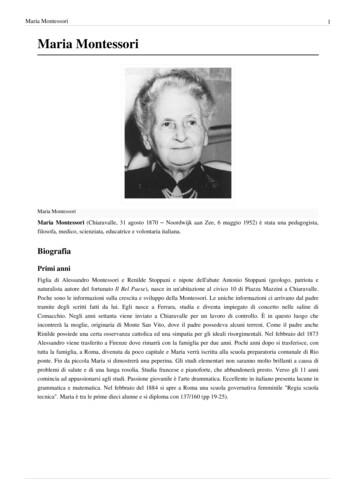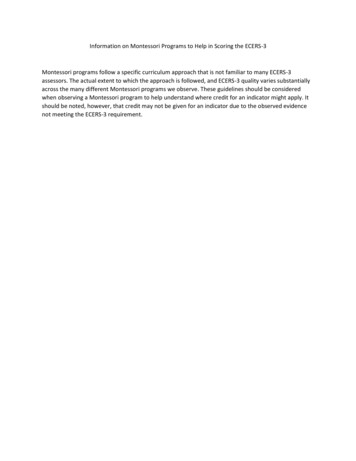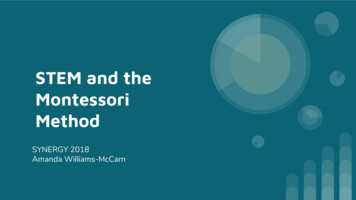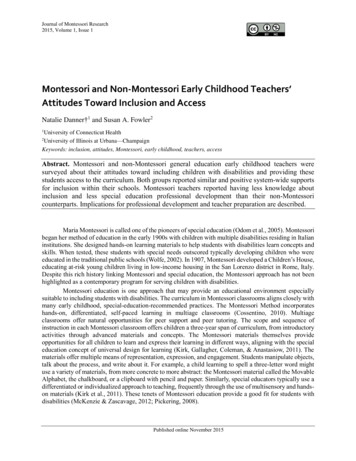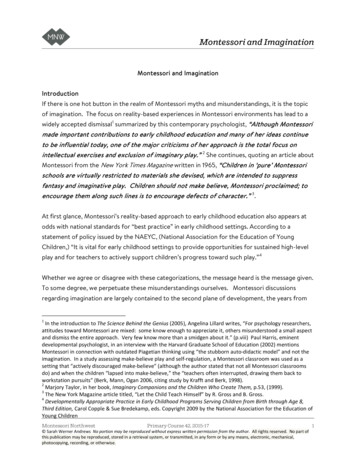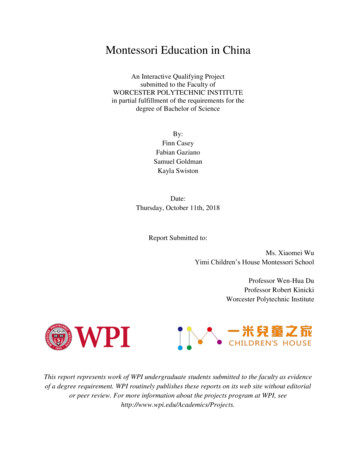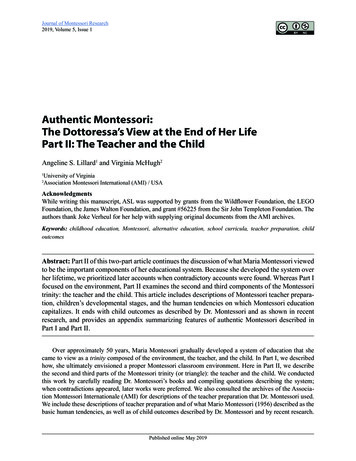
Transcription
Journal of Montessori Research2019, Volume 5, Issue 1Authentic Montessori:The Dottoressa’s View at the End of Her LifePart II: The Teacher and the ChildAngeline S. Lillard1 and Virginia McHugh2University of VirginiaAssociation Montessori International (AMI) / USA12AcknowledgmentsWhile writing this manuscript, ASL was supported by grants from the Wildflower Foundation, the LEGOFoundation, the James Walton Foundation, and grant #56225 from the Sir John Templeton Foundation. Theauthors thank Joke Verheul for her help with supplying original documents from the AMI archives.Keywords: childhood education, Montessori, alternative education, school curricula, teacher preparation, childoutcomesAbstract: Part II of this two-part article continues the discussion of what Maria Montessori viewedto be the important components of her educational system. Because she developed the system overher lifetime, we prioritized later accounts when contradictory accounts were found. Whereas Part Ifocused on the environment, Part II examines the second and third components of the Montessoritrinity: the teacher and the child. This article includes descriptions of Montessori teacher preparation, children’s developmental stages, and the human tendencies on which Montessori educationcapitalizes. It ends with child outcomes as described by Dr. Montessori and as shown in recentresearch, and provides an appendix summarizing features of authentic Montessori described inPart I and Part II.Over approximately 50 years, Maria Montessori gradually developed a system of education that shecame to view as a trinity composed of the environment, the teacher, and the child. In Part I, we describedhow, she ultimately envisioned a proper Montessori classroom environment. Here in Part II, we describethe second and third parts of the Montessori trinity (or triangle): the teacher and the child. We conductedthis work by carefully reading Dr. Montessori’s books and compiling quotations describing the system;when contradictions appeared, later works were preferred. We also consulted the archives of the Association Montessori Internationale (AMI) for descriptions of the teacher preparation that Dr. Montessori used.We include these descriptions of teacher preparation and of what Mario Montessori (1956) described as thebasic human tendencies, as well as of child outcomes described by Dr. Montessori and by recent research.Published online May 2019
JoMR Spring 2019Volume 5 (1)AUTHENTIC MONTESSORI—PART 2Lillard and McHughAs we emphasized in Part I, the term authentic is used to denote “done in the traditional or original way”(Oxford English Dictionary, 2019), not to imply that alterations to what she developed create systems thatare necessarily inferior. We urge empirical study of the variations to determine whether they improve ordetract from the system bequeathed by Dr. Montessori, and we supply the present description to provide abenchmark from which variations can be measured. We render descriptions in the present tense to reflectthat some Montessori schools today use an authentic implementation.The TeacherOur care of the child should be governed, not by the desire to “make him learn things,” butby the endeavor to always keep burning within him that light which is called intelligence.(Montessori, 1917/1965, p. 240)A Montessori teacher has three essential tasks: to prepare the environment, to set the children free in it,and, once children begin to concentrate, to observe without interfering in children’s self-construction, (i.e.,the process by which children actively and gradually create their own knowledge and understanding and,eventually, their adult self). Dr. Montessori went to great lengths to highlight the importance of a particularstyle of observation.The first step to take in order to become a Montessori teacher is to shed omnipotence and tobecome a joyous observer. If the teacher can really enter into the joy of seeing things beingborn and growing under his eyes, and can clothe himself in the garment of humility, manydelights are reserved for him that are denied in those who assume infallibility and authorityin front of a class. (Montessori, 1948/1967, p. 122)The teacher, unbeknownst to the children, thus evaluates the class on an ongoing basis and introduces newwork to children at appropriate times. Developing the necessary attitude and the sensitivity to correctlyevaluate what is needed requires that teachers have special training, which is briefly described at the end ofthis section.The Teacher’s RolePreparing the environment. The teacher’s first major task is to prepare the environment in which heor she will set each child free. This environment was mostly described in Part I; one feature of the environment not described in Part I is the teacher. Dr. Montessori was specific about how a teacher should preparehim- or herself: “The teacher expects the children to be orderly and so she must be orderly . The teacher must be well cared for and well dressed. She must be clean and tidy and form part of the attractiveness ofthe environment” (Montessori, 1989, p. 14). The authentic Montessori teacher is “warm, caring, and understanding” (Montessori, 2012, p. 114), shows “respect [and is] humble” (Montessori, 2012, p. 34). However,in relation to the children, the teacher is also “superior, and not just a friend . The teacher and the childrenare not equals [and] the children must admire the teacher for her importance. If they have no authority, theyhave no directive” (Montessori, 2012, p. 230).In Montessori theory, the teacher’s attitude toward the children is founded on a desire to serve humanityand a willingness to step out of the limelight to allow the children to show him or her where they are intheir development through their work. The greatest sign of success for a Montessori teacher is to be ableto say, “The children are now working as if I did not exist . I have helped this life to fulfill the tasks setfor it by creation”(Montessori, 1967/1995, p. 283). Many people have observed that children in Montessori classrooms do not change their behavior when the teacher is absent; rather they continue working andconversing just as they do when the teacher is there (Lillard, 2017, p. 106; Montessori, 1939, pp. 165–166).20
JoMR Spring 2019Volume 5 (1)AUTHENTIC MONTESSORI—PART 2Lillard and McHughSetting the children free. Once the environment is prepared and the children are present, there is apreliminary period before the class becomes a true Montessori class. Dr. Montessori called this “the collective stage of the class [when] the teacher can also sing songs, tell stories, and give the children some toys”(Montessori, 1994a, p. 183). The Primary teacher in this stage begins to show children how to use PracticalLife materials, conveying “interest, seriousness, and attention” (Montessori, 2012, p. 75). However, if theclass becomes chaotic, the teacher engages the children in a group activity like clapping or moving chairstogether (Montessori, 2012, p. 230). Then and always, “the teacher must first study how to help the children to concentrate” (Montessori, 2012, p. 224); early on, a teacher needs to “use any device to win thechildren’s attention” (Montessori, 1946/1963, p. 87). Teachers must be patient because “children do notbecome little angels overnight” (Montessori, 2012, p. 216). In The Discovery of the Child, Dr. Montessoridiscussed some of the difficulties encountered when establishing a classroom and how a teacher shouldrespond (Montessori, 1962/1967).But finally, one by one, children begin to concentrate. Concentration often begins with Practical Lifeactivities (Montessori, 2012, p. 74), but it could also occur with moving furniture or watching a bug: “The[Montessori] material has not yet suitable conditions for its presentation” (Montessori, 1946/1963, p. 88).Dr. Montessori noticed, and believed teachers too should notice, that with the onset of deep concentration,children’s personalities begin to change.After the children concentrate, it is really possible to give them freedom. The teachermust give them many opportunities for activity. She must give them material—an abundance of material—because once these children concentrate, they become very active andvery hungry for work . The teacher must see that there are many possibilities for work inthe environment. (Montessori, 2012, p. 232)Noninterference. Once concentration begins, Dr. Montessori was very clear: teachers must not interrupt.The teacher must recognize the first moment of concentration and must not disturb it. Thewhole future comes from this moment and so the teacher must be ready for non-interferencewhen it occurs. This is very difficult because the teacher has to interfere at every momentbefore the child is normalized. (Montessori, 1989, p. 15)Dr. Montessori used the word normalized to mean “a return to normal conditions” (Montessori, 1936, p.169), when the child is not perturbed in his or her development.As soon as concentration appears, the teacher should pay no attention, as if that child didnot exist. At the very least, he must be quite unaware of the teacher’s attention. Even if twochildren want the same material, they should be left to settle the problem for themselvesunless they call for the teacher’s aid. Her only duty is to present new material as the childexhausts the possibilities of the old. (Montessori, 1946/1963, p. 88)Dr. Montessori observed that teachers typically try to do too much. As with parents, it is difficult for themnot to interfere—they praise children or correct mistakes when, in the Montessori view, they should insteadoversee the environment in a way that protects the child’s absorption in work. She gave teachers some hintsfor how to hold themselves back from interfering with children’s self-development (e.g., wait 2 minutes orcount a string of beads; Montessori, 1994b, p. 34). She also believed that classrooms with a large numberof children and a small number of adults reduces adult interference.Dr. Montessori’s books usually describe classrooms with only a single teacher for the 30 to 40 (or evenmore) children (see Part I for citations on this point). She once mentioned a school with classrooms of 30children and one teacher and “sometimes with an assistant” (Montessori, 1989, p. 67), but assistants in theclassroom appear to have been rare. Current teacher–child ratio regulations may require more adults, but Dr.Montessori was concerned that the presence of more adults in the classroom leads to more interference with21
JoMR Spring 2019Volume 5 (1)AUTHENTIC MONTESSORI—PART 2Lillard and McHughchildren’s development. This raises two key principles that recur in Dr. Montessori’s writings: (a) every bitof unnecessary assistance given to a child interferes with the child’s self-development, and (b) the role of theteacher is limited: “In our schools the environment itself teaches the child. The teacher only puts the childin direct contact with the environment, showing him how to use various things” (Montessori, 1956, p. 138).Presentations. Besides tending the children’s environment, and respectfully giving children freedom toself-construct, integral to the Montessori teacher’s role are the timing, content, and spirit of lessons, termedpresentations, since typically a material and its use is presented. The teacher determines what a child isready for next and introduces that activity at the right moment and in a captivating way, “as something ofgreat importance” (Montessori, 1994a, p. 194). Dr. Montessori believed that “knowledge must be taken inthrough the imagination and not through memorization” (Montessori, 2012, p. 192). Correctly timing presentations requires continuous, close, and sensitive observation, as well as good record keeping and lessonplanning: “You may have a beautiful orderly class, but if you abandon it, it will be lost after a time” (Montessori, 2012, p. 237). Thus, Dr. Montessori was specific about the timing and spirit with which teachersgive presentations. For teachers to regularly and correctly present each material in a sequence in a timelymanner, they must keep detailed and organized records on each child.Evaluation. Dr. Montessori did not support the idea of tests as commonly conceived (e.g., typicalmultiple-choice tests).How can the mind of a growing individual continue to be interested if all our teaching isaround one particular subject of limited scope, and is confined to the transmission of suchsmall details of knowledge as he/she is able to memorize? (Montessori, 1948/1967, p. 6).Yet, of course, a teacher must evaluate student progress. Dr. Montessori’s books suggest that teachers evaluate students in at least two ways. First, the teacher observes children intensely, noticing what they are doingand appear to understand. In the course of this observation, a teacher may notice a child using a materialincorrectly; for example, a child may neglect to trace the outside of a geometric form. In theory, this tracingaction embodies the concept; for example, the child feels with his or her hand and arm what a pentagon is.Therefore, by neglecting to trace the shape, the child fails to embody the concept. In such a case, no immediate correction is given. What matters is that a child is engaged with the material; correctness will come.“If we correct him, we humiliate and discourage . So the only way to correct the child is to prepare thismaterial and give him the technique” (Montessori, 1994a, p. 191). The teacher simply notices the child’serror and gives the presentation again later. Dr. Montessori expressed faith that through repetition, childrenwill eventually learn, and that problems will typically be resolved without teacher correction. Her belief isconsistent with the idea that humans under normal conditions have a tendency toward virtuosity; they getpleasure out of striving toward perfection (Kubovy, 1999). Since most Montessori materials have the feature of control of error, meaning the materials reveal one’s mistakes, then if children do naturally strive forperfection, repetition will naturally lead to children using materials in the right way. The second way thatteachers evaluate student progress is to check, via observation or discussion, children’s knowledge prior toor while presenting a new lesson. This process is formalized in the three-period lesson (Montessori, 1994a,p. 204), in which teachers first give new information and then, in the course of conversation or throughstudents’ work, see that children can recognize the information, and, finally, in the third period, that childrencan even recall the information without prompting.Supporting this last point, psychologists have discovered a testing effect: when people have alreadylearned information (e.g., which new foreign word corresponds to a native word), future retrieval of thatknowledge is improved not so much by further study as by repeated testing of the material (Karpicke &Roediger, 2008). One might ask if the testing effect means Montessori education would do well to test children in more-typical ways, but testing is built into the system Dr. Montessori designed. As just noted, thesecond two periods of the three-period lesson are recognition and recall tests. In addition, when childrenlearn material, they try to recall what they can (e.g., the names of African countries while doing a Puzzle22
JoMR Spring 2019Volume 5 (1)AUTHENTIC MONTESSORI—PART 2Lillard and McHughMap), and then they use a different material (e.g., a Control Map) to determine for themselves whether theywere correct. A third type of recall test that children repeatedly engage in after age 6 involves presentingmaterial to others, as when giving oral reports. Montessori education therefore may already involve repeated, but perhaps relatively unstressful, testing of the sort that has been shown to improve learning.In sum, an authentic program has a single Montessori teacher whose task is to guide, facilitate, and observe the community of children. In many places today, more adults are required in the classroom for stateaccreditation, a change to Dr. Montessori’s approach that is ripe for empirical study.Teacher PreparationDr. Montessori believed teaching with her system required self-study and sometimes even fundamental change: “A Montessori teacher must be created anew, having rid herself of pedagogical prejudices”(Montessori, 1946/1963, p. 86). She spoke repeatedly of teacher preparation involving spiritual and moraltransformation, cultivating humility and patience, sympathy and charity.This method [of education] not only produces a reformed school but above all a reformedteacher, whose preparation must be much deeper than the preparation traditionally offered. [The] mission is to be a scientist and a teacher: a teacher in the sense of an observerwho respects life, drinking in the manifestations and satiating [the] spirit. Hence it greatlyraises the personality of the teacher. (Montessori, 2013, p. 276)She said that the transformation to becoming a real teacher requires time and deep personal work.It is not so easy to educate anyone to be a good teacher. It is not enough to study at auniversity. Perfection is a part of life; in order to achieve it, we must make a long study.Conversion cannot come to everybody. We must patiently try to understand and act on ourunderstanding. Our conversion must be in the heart. (Montessori, 2012, p. 26)The teacher preparation required for both undergoing this personality change and learning the Montessorisystem, including its extensive set of materials, is quite involved.The teacher preparation that Dr. Montessori ultimately delivered lasted about five months and includedabout 180 hours of lectures on the principles of education and child development, as well as lectures thatincluded demonstrations of how to present and use the materials, how to prepare the classroom, and theteacher’s role in starting and conducting the class (Montessori, 1948; see Figure 1). At its most developed(Montessori, 1994b, 2012), teacher preparation included more than 50 hours of lectures to cover all thematerials, including their presentation, direct and indirect aims, target age range, and how the materialsare self-correcting. There were also 50 hours of classes in which teachers-in-training practiced presentingthe materials until they could do so perfectly and in which they also experimented with alternative ways ofusing the materials.To keep a child within certain limits, [the teacher] must offer the material to [children],following a certain technique. So the teacher must have a direct communication with thismaterial, and use it with the necessary exactitude. She must practice repeatedly in order toexperiment and discover within herself the difference between using the material incorrectly and using it with exactness. (Montessori, 1994b, p. 107)Dr. Montessori urged teachers to experience the materials as a child would. In her own house, she often leftmaterials out on the coffee table for continual exploration (Standing, 1957).To enable teachers to learn to see children objectively and detect their needs, training also required atleast 50 hours of observation: “The eyes of the teacher must be trained. A sensitivity must be developed inthe teacher to recognize this ephemeral phenomenon of concentration when it occurs” (Montessori, 2012, p.226). Eventually in this process, a developing teacher becomes “aflame with interest, ‘seeing’ the spiritual23
JoMR Spring 2019Volume 5 (1)AUTHENTIC MONTESSORI—PART 2Lillard and McHughFigure 1. Description of a Montessori teacher preparation course (Montessori, 1948).phenomena of the child, and experiences a serene joy and an insatiable eagerness in observing them . Atthis point she will begin to become a ‘teacher’” (Montessori, 1917/1965, p. 141). Along with the teachertrainer monitoring and observing these developments in budding teachers, written and oral exams wereadministered at the end of the courses. Oversight of the examinations for AMI courses was (and remainstoday) centralized at AMI headquarters in Amsterdam.To help teachers-in-training to learn the material as well as to provide a manual and guide for their laterteaching, they were also required to create reference books, often referred to as albums, rendering theirlecture notes complete with illustrations, which the teacher trainers read for accuracy and understanding.Supporting this practice, research suggests that writing one’s own notes—and by hand, not with a computer—results in a deeper conceptual understanding of the material (Mueller & Oppenheimer, 2014).We have provided details about the teacher preparation provided by AMI because it is the organizationDr. Montessori founded to carry on her work and thus fits our definition of authentic or the state of the artat her death. It may be of interest to readers that her son Mario extended the duration of AMI courses to atleast one academic year (personal communication, J. Verheul, January 31, 2018, based on a letter from Mario M. Montessori to Prof. Sulea Firu, December 1, 1976). He appears to have taken this action because heand Dr. Montessori found that even the intensive teacher-preparation courses were not necessarily enoughto prepare a teacher.Sometimes, the teacher in our schools succeeds very quickly and very easily. Very often shesucceeds in practice only after long experience. This depends upon the nature of her spirit.24
JoMR Spring 2019Volume 5 (1)AUTHENTIC MONTESSORI—PART 2Lillard and McHughShe may need a long period of training in order to change her spirit and give it anotherform. This comes with practice, contact with children, and experience. (Montessori, 1994a,pp. 104–105).Demonstrating that the course itself had not always fully prepared them, teachers wrote letters to Dr. Montessori describing their classes and soliciting advice after training was over.Dr. Montessori did not consider completion of her course sufficient for becoming a trainer of newteachers; the course pamphlets and diplomas from as early as 1914 explicitly stated that the diploma enablespupils to direct Children’s Houses but not to train other teachers. It is unclear what she required for othertrainers, as there were very few in her lifetime. Her son Mario was a trainer for the 1939 India course (hehad received his diploma in 1925), and Claude Claremont ran a 2-year residential course in London. Undoubtedly, there were others whom she believed understood the system well enough to train teachers, andothers helped with the practicums; for example, the Edinburgh brochure excerpted in Figure 1 named threepeople who did lecture demonstrations and practical work for the course.SummaryDr. Montessori believed that the teacher’s role is to prepare the environment and then set the childrenfree there, connecting children to the materials at appropriate times to engender states of deep concentrationand wonder. Careful and astute observation is required to determine when interference is helpful, whenchildren have mastered a material, and what new materials to present and when. Teachers typically want todo too much; learning to sit back and not interfere is crucial. In addition to listening to lectures, engagingin practicums, doing observations, creating albums, and passing examinations, Montessori teachers wereexpected to undergo a deep, spiritual transformation.The ChildDr. Montessori had a particular view of children and saw particular outcomes resulting from the systemshe developed.The child is capable of developing and giving us a tangible proof of the possibility of abetter humanity [and] has shown us the true process of construction of the whole humanbeing. We have seen children totally change as they acquire a love for things and as theirsense of order, discipline and self control develops within them . The child is both a hopeand promise for mankind. (Montessori, 1932/1992, p. 35)In this section, we discuss Dr. Montessori’s view of children, along with her stage theory and the human tendencies around which the Montessori system is constructed. Finally, we elucidate her view of theoutcomes of this system of education.How Development OccursUnderpinning Montessori education is a view of children that was revolutionary in the early 1900s butis well accepted today. Fundamentally, this view is that, although children can be taught pieces of information (Harris, 2012), development occurs through self-construction. Conventional education is more oriented to the former view (see Resnick & Hall, 1998), whereas Montessori education is oriented to the latter.Dr. Montessori derived her views about self-construction from watching very young children. Humanbabies essentially teach themselves how to get milk from the breast, grasp objects, crawl, and walk. Sheoften used the example of language, noting that at around four months of age, children become intensely fo25
JoMR Spring 2019Volume 5 (1)AUTHENTIC MONTESSORI—PART 2Lillard and McHughcused on adults’ mouths when the adults speak (e.g., Montessori, 1961/2007, p. 27), a conclusion confirmedby current scientific methods (Lewkowicz & Hansen-Tift, 2012). Long before Noam Chomsky (1993) became famous for the same idea, Dr. Montessori repeatedly pointed out that learning language is an innateability and that children everywhere learn language on a similar schedule, despite the varying levels ofcomplexity of the different languages they learn. Further, they are not taught to do this; rather, they absorblanguage from the environment. Language is a supreme example of how children self-construct when theirenvironment provides them appropriate raw material and the freedom to develop themselves. Assistingtheir self-construction is the fact that they gravitate to their “zone of proximal development” (Vygotsky,1978), in other words, what is just beyond their current level of development. For example, infants seekstimuli that are challenging (but not too challenging) for them to perceive, a phenomenon recently dubbedthe Goldilocks effect (Kidd, Piantadosi, & Aslin, 2012, 2014).Dr. Montessori believed a children’s self-construction has a blueprint and is guided by mental powersthat are unique to each developmental period, stages she termed planes of development, which are depictedin Figure 5 in Part 1, where they were discussed with reference to the environment and materials offered ateach stage. Here we discuss the stages with reference to children.Planes of DevelopmentDr. Montessori attributed to William James an insight that child development can be likened to themetamorphic stages of a butterfly (Montessori, 2017), in that development is not simply a matter of growingand accruing, but that at each stage a child has a fundamentally different mind. Her system of education wasadjusted at each stage to meet children’s changing needs. Like many other theorists (see Part I), she sawthree main stages of childhood, and a fourth stage as one enters adulthood (not discussed here).The first plane: The absorbent mind. For a newborn child, the world is in most ways completely novel—all the sights and smells and tactile elements are new; only the sounds that penetrated the uterine walland some tastes are familiar. Children are also relatively helpless, beholden to their caretakers for food andshelter. However, newborns also have the power to build their future selves and eventually become personsof their time, place, and culture. Certain qualities assist this early development and characterize the periodfrom birth to 6 years.Dr. Montessori observed that during this first stage, children effortlessly absorb many aspects of theenvironment, including language and culture, and that they do so without fatigue. This absorption is indiscriminate, incorporating both good and bad. However, these qualities disappear by the age of 6, whenconscious learning takes hold.This absorbent mind does not construct with a voluntary effort but according to the lead of“inner sensitivities” which we call “sensitive periods” as the sensitivity lasts only untilthe acquisition to be made according to natural development has been achieved. (Montessori, 1949/1974, p. 85)During sensitive periods, particular elements in the environment evoke very strong interest, facilitatinglearning. For example, Dr. Montessori described the age of 2 as a sensitive period for order; she noted thatchildren who see things out of place become upset and try to restore order (e.g., Montessori, 1967/1995, pp.134–135). Montessori education capitalizes on these theorized sensitivities, for example, by showing youngchildren precise ways to use and store materials.Little children have, during their sensitive periods, powers that disappear later on in life.Once a sensitive period is over, the mind has acquired the special faculty, which this sensitivity helped construct; the individual must now learn in a different way. Whereas the small26
JoMR Spring 2019Volume 5 (1)AUTHENTIC MONTESSORI—PART 2Lillard and McHughchild learns easily, older children learn because they wish to learn, but they do so witheffort. (Montessori, 2012, p. 18)The second plane: The reasoning mind. “The passage [from the first] to the second level of educationis the passage from the sensorial, material level to the abstract” (Montessori, 1948/1976, p. 11). During thisperiod, Dr. Montessori claimed children have an insatiable appetite for knowledge and are eager to explorewith a reasoning mind, which begins to assert itself strongly: “From seven to twelve years, the child needsto enlarge his field of action” (Montessori, 1948/1976, p. 9). Children start wanting to understand the reasons behind things. No longer satisfied in a small community of the family and the preschool classroom,a child in the second plane wants to be part of a herd and engage predominantly in small-group work. Thechild “will try to get out, to run away, a
activities (Montessori, 2012, p. 74), but it could also occur with moving furniture or watching a bug: "The [Montessori] material has not yet suitable conditions for its presentation" (Montessori, 1946/1963, p. 88). Dr. Montessori noticed, and believed teachers too should notice, that with the onset of deep concentration,
